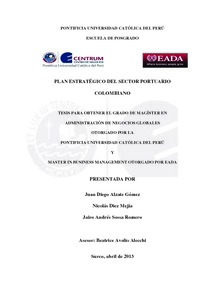| dc.contributor.advisor | Avolio Alecchi, Beatrice Elcira | |
| dc.contributor.author | Alzate Gómez, Juan Diego | es_ES |
| dc.contributor.author | Diez Mejía, Nicolás | es_ES |
| dc.contributor.author | Sossa Romero, Jairo Andrés | es_ES |
| dc.date.accessioned | 2018-09-22T00:27:24Z | |
| dc.date.available | 2018-09-22T00:27:24Z | |
| dc.date.created | 2013 | |
| dc.date.issued | 2018-09-21 | |
| dc.identifier.uri | http://hdl.handle.net/20.500.12404/12697 | |
| dc.description.abstract | El presente plan estratégico aplicado orienta el Sector Portuario Marítimo
Colombiano hacia una visión al año 2013. El sistema portuario colombiano posee las
condiciones para ubicarse dentro de los 10 mejores del mundo según el índice de
competitividad mundial. Se parte de una era de alta corrupción y atraso que concluye
con la Ley 1 de 1991 que inicia la gran conversión. Desde 1991 a 2013, el sector se
ha desarrollado bajo la protección a la inversión extranjera, la gran apalancadora del
sector, una extrema sujeción a la libre competencia, y el reciente florecimiento de los
tratados de libre comercio.
Colombia posee una ventaja comparativa fundamental, que es la salida al
Pacífico y al Atlántico. En este PEA, se propone como estrategia fundamental
retenida la construcción de un puerto de alto calado natural en el Pacífico, en Tribugá,
la construcción de dos hubs interlands para abastecer las ciudades de Medellín y
Bogotá y en sentido general, propone una serie de acciones que conduzcan hacia la
alta competitividad basada en la gente, la certificación de los mejores estándares de
calidad, el crecimiento sostenible y en últimas, la implementación de la
responsabilidad social como directriz del crecimiento empresarial colombiano.
Este PEA plantea la necesidad de articular el sector portuario con la
construcción de carreteras, tramos férreos, y establecer ajustes legales relacionados a
los mejores estándares de industria mundial.
La planeación de este sector se origina del grupo de estrategas que lo crea y
redacta y se apoya en criterios tomados de expertos del sector, el amplio conocimiento
del mercado, y de la metodología de planeación estratégica del profesor Fernando
D´Alessio, Director General de CENTRUM Católica | es_ES |
| dc.description.abstract | This Applied Strategic Plan points in the direction and orients the Colombian
Maritime Ports Sector towards a 2030 vision. The Colombian Maritime Ports Sector
has the strengths and is exposed to the opportunities to be in worlds top 10 ports in
accordance to the worlds Competitive Index. We part from an era of high corruption
levels and lack of development and competitiveness and begin a new era with the
passing and signing of the 1 law of 1991 that gave birth to the great transformation
period. Since 1991 to present moments, the seaports sector has developed jointly with
the inflows of foreign direct investment capitals, the greatest leverage tool for the
sector, and the extreme union and promotion of free competition as well as the
flourishing free trade agreements the country has successfully signed and is actively
seeking.
Colombia has a fundamental comparative advantage and that is the access to
both the Atlantic and Pacific Ocean. In this Applied Strategic Plan, it is proposes as a
fundamental retained strategy the construction of a new port in the Pacific Ocean with
the right natural draught depth in Tribuga, Choco and the construction of two inland
hubs that can connect and meet supply and demand needs for Bogota and Medellin, a
race towards high competitiveness based on people development, the certification of
the worlds best quality standards, sustainable growth and development and last but
not least, the implementation of social responsibility as a core requirement for the
continued growth of the Colombian business sector.
This Applied Strategic Plan proposes and traces the necessity to articulate the
maritime ports sector with the construction of new roads, new railroad sections and
establish legal adjustments in accordance to the best world's standards practiced in the
industry | es_ES |
| dc.language.iso | spa | es_ES |
| dc.publisher | Pontificia Universidad Católica del Perú | es_ES |
| dc.rights | info:eu-repo/semantics/openAccess | es_ES |
| dc.rights.uri | http://creativecommons.org/licenses/by-nc-nd/2.5/pe/ | * |
| dc.subject | Puertos--Colombia | es_ES |
| dc.subject | Transporte marítimo--Colombia | es_ES |
| dc.subject | Planificación estratégica | es_ES |
| dc.title | Plan estratégico del sector portuario colombiano | es_ES |
| dc.type | info:eu-repo/semantics/masterThesis | es_ES |
| thesis.degree.name | Maestro en Administración de Negocios Globales | es_ES |
| thesis.degree.level | Maestría | es_ES |
| thesis.degree.grantor | Pontificia Universidad Católica del Perú. CENTRUM | es_ES |
| thesis.degree.discipline | Administración de Negocios Globales | es_ES |
| renati.discipline | 413307 | es_ES |
| renati.level | https://purl.org/pe-repo/renati/level#maestro | es_ES |
| renati.type | https://purl.org/pe-repo/renati/type#tesis | es_ES |
| dc.publisher.country | PE | es_ES |
| dc.subject.ocde | https://purl.org/pe-repo/ocde/ford#5.02.04 | es_ES |






